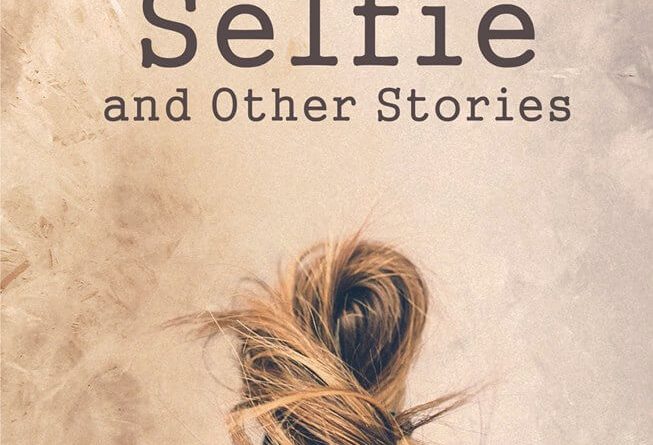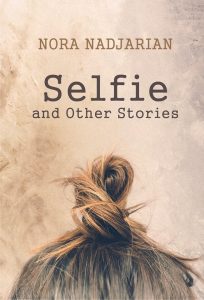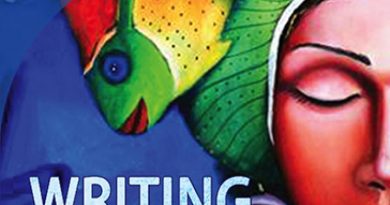Selfie and Other Stories by Nora Nadjarian
– Reviewed by Jenny Booth –
Would you like to read experimental writing that explores the liminal space between consciousness and reality in a poetic and image rich way? Great. Please buy Selfie and Other Stories by Nora Nadjarian. Send Roman Press a thank you note for publishing such unusual writing.
Selfie and Other Stories is a collection of enigmatic writing that dispenses with the conventional short fiction dictats of ‘beginning, middle and end,’ or often even a plot that would be possible to summarise. There are 24 short pieces in this 88 page collection. While some would fit the description of short story, others are more fragmentary, in terms of both their word count and the intention to create a poetic moment rather than a traditional narrative.
The subject of some of the pieces is relatively straightforward. ‘Mrs. Gaslight’ and ‘Blue Pear’, for example, describe women experiencing domestic abuse. However, they are unusual and clever in their approach. The narrative advances by peeling away layers of perception, with a well executed impressionistic portrayal of the women’s thoughts. Nadjarian often utilises a kind of negative space technique, focussing on the sensations and memory associated with an event to tell her stories rather than approaching the event directly. In ‘The Republic of Love’, this is used to powerful and moving effect as the nature of the characters’ losses (and possible redemption) is gradually revealed. The imagery of maps, birds, a vacant house, are returned to and altered throughout this story as a way of demonstrating the development of the plot and characters.
The stories in Selfie explore how dreams and the unconscious can be equally as constitutive of a character’s reality as the material. ‘Origami’ describes a mother who avoids engaging with family dynamics by making elaborate origami figures. It brilliantly switches between this ‘real life’ and her child’s fantasy, where the paper figures come to life in a way that answers the child’s real emotional needs. One of the most enjoyable by-products of this is Nadjarian’s exuberance and creativity in writing the child’s magical imaginary world.
Other stories in the collection are less transparent about their subject matter. The opener ‘Exhibition’ seems to be about (among other things) family betrayal, the process of writing, the construction of female sexuality, and memory. ‘Mapless’ could be a person experiencing a breakdown, or a slant way of describing loss of national identity. ‘Sparrow’ could hint at incest. The prose is poetic and evokes feeling and sensation, even if a definite overall meaning isn’t clear. The images found throughout the collection are memorable and striking. One character dreams of her mother making jam, ‘Too red to be true. Like pulped strawberries and raspberries and red paint and hearts and period blood all together as one.’
The collection is put together thematically, and clues to one story could be contained in adjacent ones. In ‘The Journey’, Katerina, the main character, is pregnant, and imagines announcing this to a conference she is presenting to, along with the information that the father is one of the other delegates. Katerina reflects, ‘in an ideal world, it would have been a dream come true: Katerina pregnant with the man she loved. In real life, things were different, all terribly wrong.’
What the wrongness is (apart from the wrongness of delivering such a revelation with an academic paper) is left ambiguous. In the subsequent story ‘The Gentleman on the Train’, the narrator uses her fellow passenger’s silence as space to engage in a seduction fantasy. This has an effect on the reading of ‘The Journey’. On a first reading, wrongness could just mean doubts about the pregnancy and the relationship, but the wider context introduces the question of how much of what Katerina tells the reader is her imagination.
‘The Gentleman on the Train’ is also perhaps one of the weaker pieces. Constructing unlikely fantasies about the person sitting opposite you is a good way to while away a boring train journey but not the most fascinating material for an outside observer, though Nadjarian’s prose is consistently entertaining. The same could be said of ‘The book of desperate dreams’ where the narrator recounts a series of dreams to their therapist. In some of the stories real life characters, Sigmund Freud, Etgar Keret and Franz Kafka make an appearance. My impression is that these are writers that invoke a deep personal response for Nadjarian, which is as important for her to explore in her writing as other themes like family and loss. However, introducing other writers into fiction could have the effect of inviting comparison or symbolic significance that isn’t necessarily intended; although aficionados of these writers might be able to discover deeper layers of meaning.
Selfie and Other Stories is an intriguing and original collection of writing. It not only challenges the conventions of the short story format, but on a deeper level, has an innovative and illuminating view on how we interpret and describe reality.






